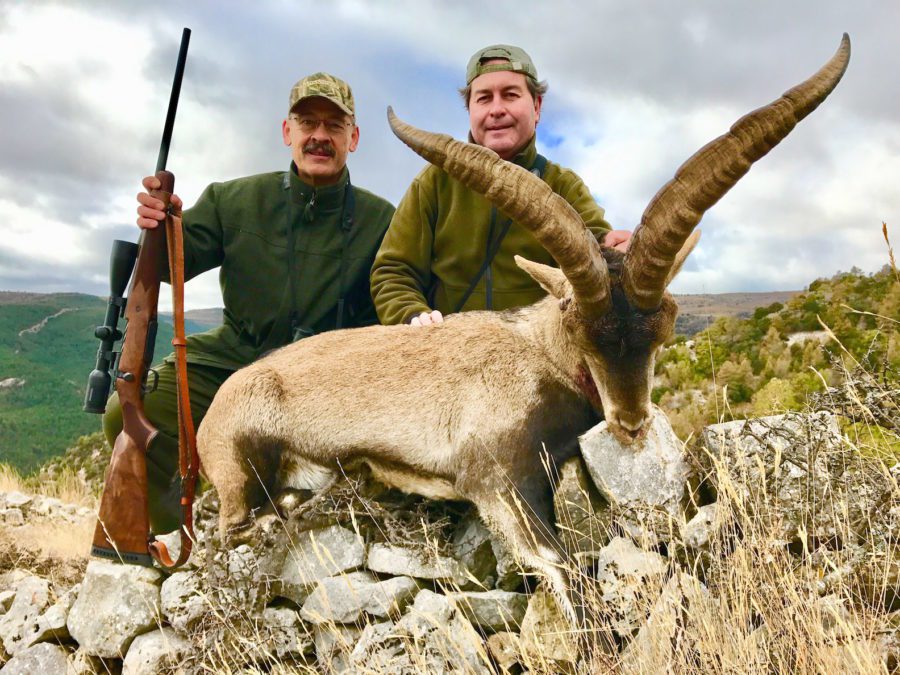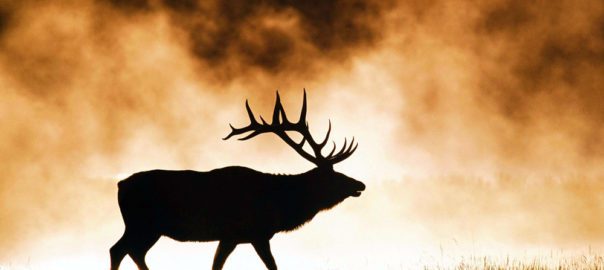An acquaintance was complaining recently that the “overhyped” 6.5 Creedmoor really gets his goat. I have to agree. The 6.5 Creedmoor really got my goat, too. In Spain. At 350 yards.
At the risk of sounding like some kind of overhyped 6.5 Creedmoor nutjob myself, I must report on this week’s hunting experience with that little cartridge. The two Beceite ibex I took were just the third and fourth game animals I’ve ever taken with the 6.5 Creedmoor. (The previous two were whitetails which I’ll report on at another time.) This pre-Christmas holiday hunt was unusual and unusually successful, and my three shots highlight some of the attributes of the 6.5 Creedmoor that suggest it may not be overhyped.
I ended up in Spain (for the first time) thanks to my hosts, Mossberg and Swarovski. They booked the trip through World Slam Adventures. As often happens in this business, they hosted a couple of writers as a way of introducing them to their products in a meaningful way. Let’s face it: If a writer had to bankroll all his own guns, gear, and trips, he wouldn’t have much to report. This doesn’t mean we become shills for the manufacturers. We are free to report the good, bad, and ugly. If a product doesn’t work as advertised, I’ll not recommend it. And that makes this quick report easy because the Mossberg Patriot Revere and Swarovski optics functioned to perfection.
I’ll report in depth on this gear in a future article. For now, let’s see how the 6.5 Creedmoor performed.
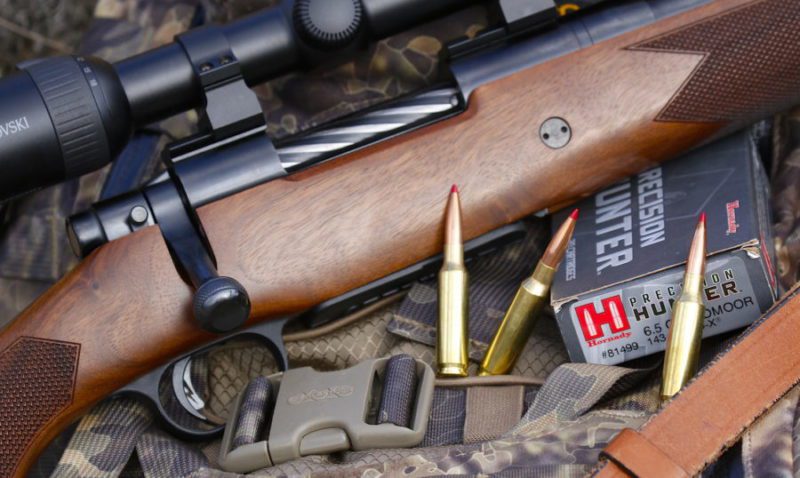
The “overhyped” 6.5 Creedmoor is a short, efficient cartridge designed to shoot long, high-B.C. bullets that minimize wind deflection and recoil. The 143-grain ELD-X is one of the better long-range hunting bullets for this cartridge.
I was shooting Hornady’s new Precision Hunter loads featuring 143-grain ELD-X bullets. They chronographed an average muzzle velocity of 2,689 fps from the 24-inch barrel of my borrowed Revere rifle. I didn’t have time for extensive accuracy testing, but a few three-shot groups fell in the 1- to 1½-inch range. That’s more than adequate to hit an 8-inch circle out to 500 yards, and I wasn’t planning to shoot that far. Nor did I have to.
The Z5 3.5-18x44mm scope provided more than enough magnification for careful targeting, and my old Steady Sticks bipod promised solid support in a hurry on virtually any terrain. My first opportunity came at sunset on the first day as local guide Oscar, working for outfitter Hunt Spain (cazahispanica.com), guided me carefully along the rimrock of a steep, dry canyon lined with rock-retaining walls built over hundreds of years by land-hungry peasants.
The goats had been crossing the canyon when we first spotted them. Two were absolute monarchs with towering, curving horns perhaps four feet long. These were off-limits due to their value. In Spain, local villages sell permits to hunt their surplus ibex, and they charge what the market will bear—close to $30,000 for a top-end billy. We were hunting the more affordable “bronze” quality billies, roughly 6- to 9-year-old animals.
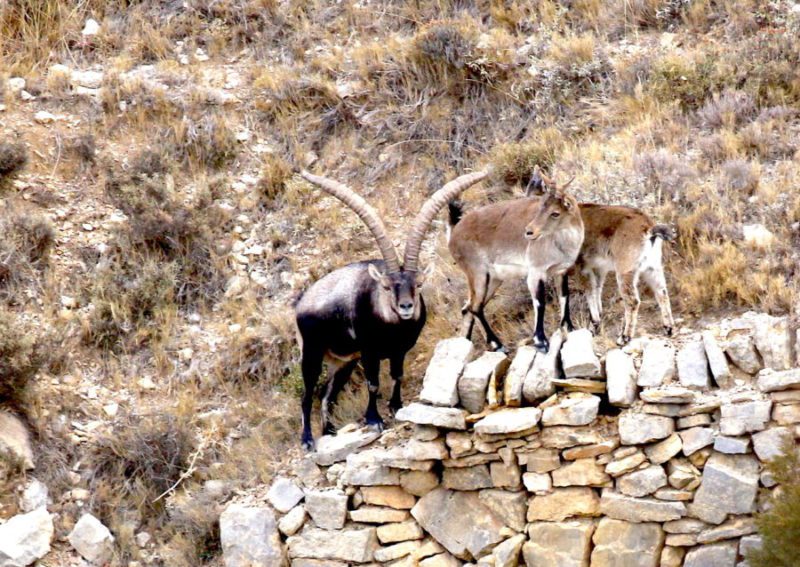
A big, mature Beceite ibex billy costs more to hunt than a big Alaska/Yukon moose. They get blacker with age. This could be a 12-year-old billy.
Let me assure you, it was weird passing up the biggest, oldest animals, but this is the way of hunting today. Supply and demand. You can’t blame rural villagers with limited resources for charging what they can for a natural resource.
At any rate, when Oscar pointed out a bronze-class male picking its way across a distant rockslide, I lay prone with the Mossberg resting over his pack on the rimrock. Then I chambered a round, asked for the range (260 yards), held middle of the shoulder, and launched that long, sleek, wind-defying ELD-X. It landed low on the shoulder, as anticipated, breaking the animal’s leg and penetrating its heart. Of course, in the heat of the moment I only knew that the front leg was broken, and that could have been from a low strike, so I sent a second bullet over the gaping Spanish countryside. This one landed a few inches higher than the first, and the billy expired right on one of the old terraces.
If the rifle had recoiled, I didn’t feel it. Even in a light, sporting rifle like the Revere, 6.5 Creedmoor recoil is so light that one can usually recover well enough to see the result of the shot—even through a scope set at 10X.
Overhyped 6.5 Creedmoor or not, both the cartridge, bullet, rifle, and scope performed perfectly. I had my first Spanish Beceite ibex, a beautiful male that smelled as bad as the old billy goat we had back on the farm. Once a goat, always a goat, I guess.
My second animal was a bonus due to an extra tag unused by a hunter who had fallen ill. We had one morning to hunt. Caza Hispanica founder and head guide Vicente Gil personally led me on the search. It ended when my Swarovski 8×30 Companion binoculars enlarged five nannies and a billy far up a canyon wall.
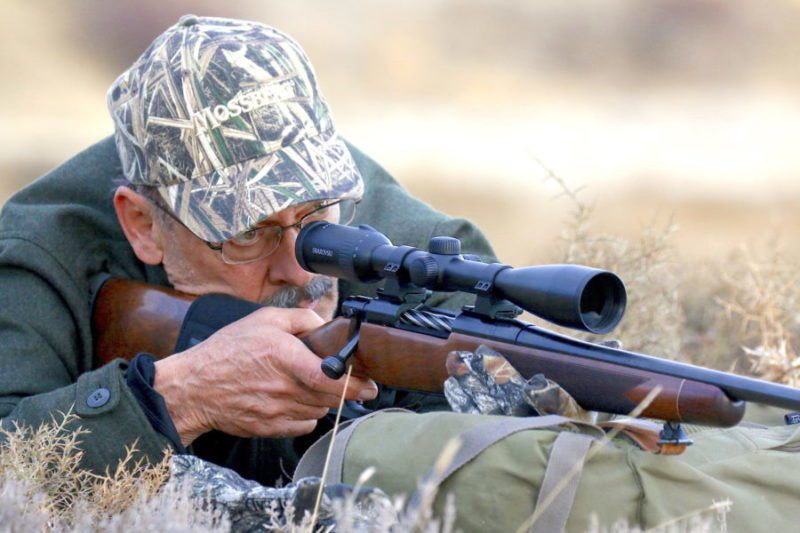
From this improvised prone position, I launched two 143-grain 6.5 Creedmoor bullets into the shoulder of an ibex billy 260 yards away. Overhyped or not, this little cartridge did a fine job, and the Revere looked good carrying it.
“Ees good one,” Vicente said. “Want to try him?”
I did. We set off on a steep, winding climb up our side of the canyon, hoping it would bend close enough for a shot. The animals watched us warily, but confidently, probably well aware that the deep canyon between us gave them plenty of protection. They hadn’t heard about the overhyped 6.5 Creedmoor.
But there was a problem: a larger billy. Why this older, more heavily horned male was not with the band will remain a mystery, but his position between us made a closer stalk unlikely.
“Can you shoot from here?” Vicente asked. “Here” was a walled redoubt at the base of the cliffs where fighters had dug in during Spain’s civil war.
“Probably. But the wind . . .”
As often happens in canyon country, winds were gusting and variable, sweeping down the canyon, curling up and sometimes pouring back. We estimated the range at 350 yards. Given my zero-range of 240 yards, my bullet would drop 11 inches at 350 yards, deflecting about 7½ inches in a 10-mph breeze. This was anything but a steady breeze.
I set up with my back against a rock, elbows on my knees, the Patriot’s walnut stock in the old Steady Sticks. Rock solid. I then studied the trees near the goats and halfway to them to get a better fix on the wind. To my surprise, they were still, yet blowing considerably where I sat. I waited. During a lull, I held about six inches over the billy’s back, about four inches into my wind, and tripped the rifle’s 3½-pound trigger.
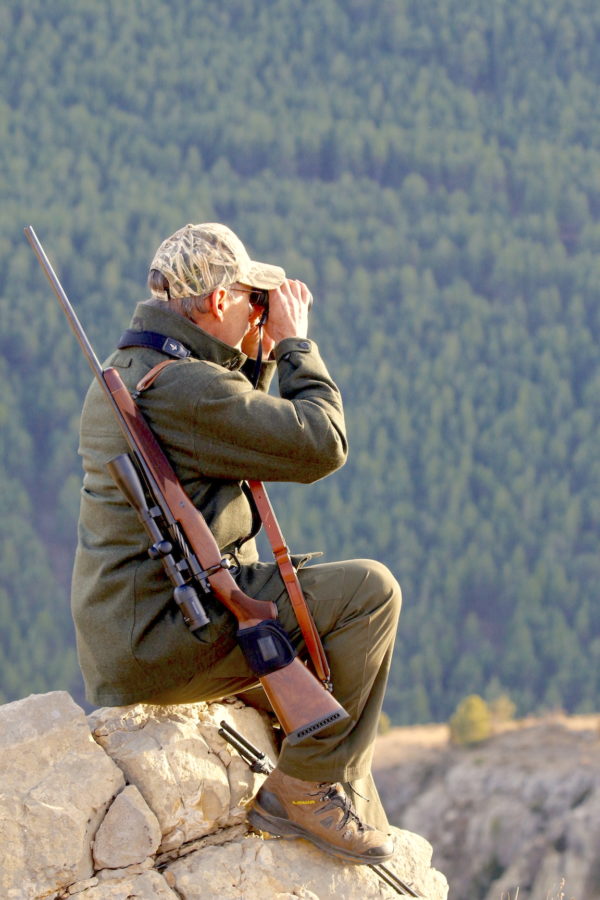
My position atop this rocky perch gives you some idea of the big country in which we hunted. I was wearing a traditional Jagdhund wool jacket that cut the wind nicely, turned thorns, and fit well.
As the rifle recovered from the slight recoil, I saw rock dust erupt. Ewes scattered. I thought I’d missed high.
“Where’d he run?” I asked Vicente.
“No run. Kaput!”
“Kaput?”
“Kaput!”
I’d overcompensated for the wind and apparently caught a contrary gust that deflected the bullet three or four inches right of where I’d intended. That put it in the neck instead of the chest. The billy had collapsed right there.
This is one of the advantages of those long, high-B.C. 6.5mm bullets. They minimize wind deflection, and that can sometimes save you from a bad call. The 6.5 Creedmoor doesn’t shoot as flat as a .270 Winchester or 7mm Rem. Mag., but it throws high-B.C. bullets at low recoil. This gives you the luxury of seeing your hits or misses.
This is part of the reason why the overhyped 6.5 Creedmoor might not be all that overhyped after all. Our field research is just getting started. We’ll see what else develops.
For more from Ron Spomer, check out his website, ronspomeroutdoors.com, and be sure to subscribe to Sporting Classics for his rifles column and features.
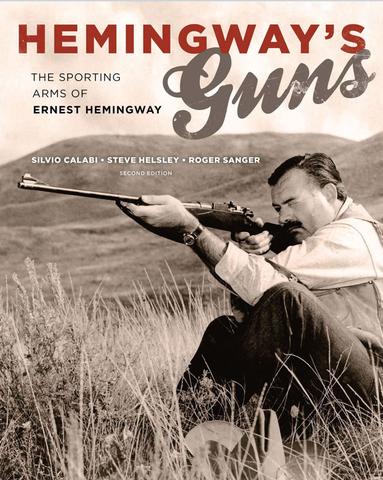 Ernest Hemingway’s friend A.E. Hotchner once described a “yellowed four-by-five picture of Ernest,” shown him by Hemingway, “aged five or six, holding a small rifle. Written on the back in his mother’s hand was the notation, ‘Ernest was taught to shoot by Pa when 2½ and when 4 could handle a pistol.’”
Ernest Hemingway’s friend A.E. Hotchner once described a “yellowed four-by-five picture of Ernest,” shown him by Hemingway, “aged five or six, holding a small rifle. Written on the back in his mother’s hand was the notation, ‘Ernest was taught to shoot by Pa when 2½ and when 4 could handle a pistol.’”Firearms and shooting infused Hemingway’s existence and thus his writing. He was a member of his high-school gun club and went to war when he was eighteen. He hunted elk, deer, and bear in the American west and went on two extended African safaris, which figured hugely in his writing and changed his life. To the day of his death, Hemingway remained an avid hunter, first-class wingshot, and capable rifleman.
Following years of research from Sun Valley to Key West and from Nairobi, Kenya to Hemingway’s home in Cuba, this volume significantly expands what we know about Hemingway’s shotguns, rifles, and pistols—the tools of the trade that proved themselves in his hunting, target shooting, and in his writing. Weapons are some of our most culturally and emotionally potent artifacts. The choice of gun can be as personal as the car one drives or the person one marries; another expression of status, education, experience, skill, and personal style. Including short excerpts from Hemingway’s works, these stories of his guns and rifles tell us much about him as a lifelong expert hunter and shooter and as a man. Buy Now

